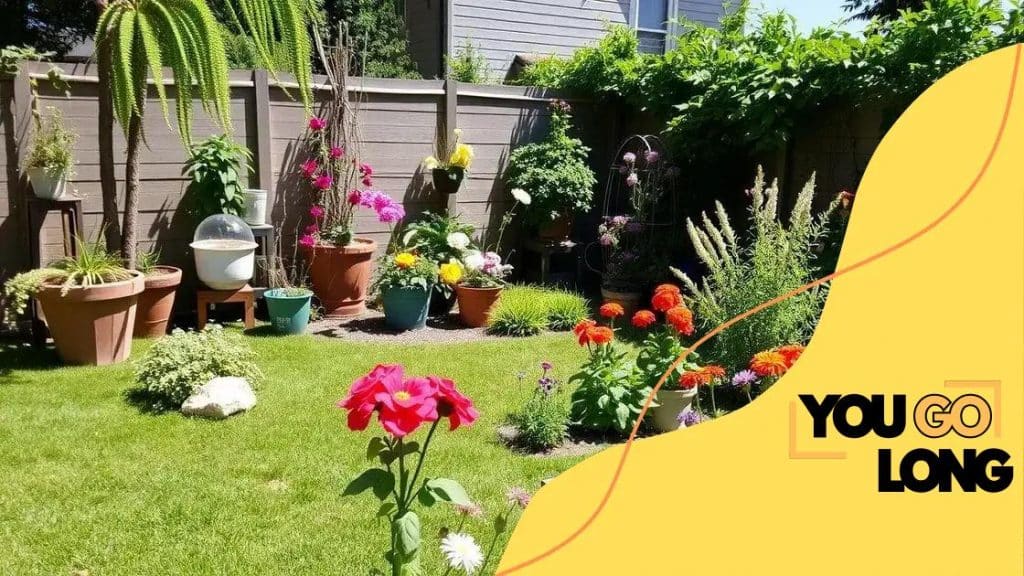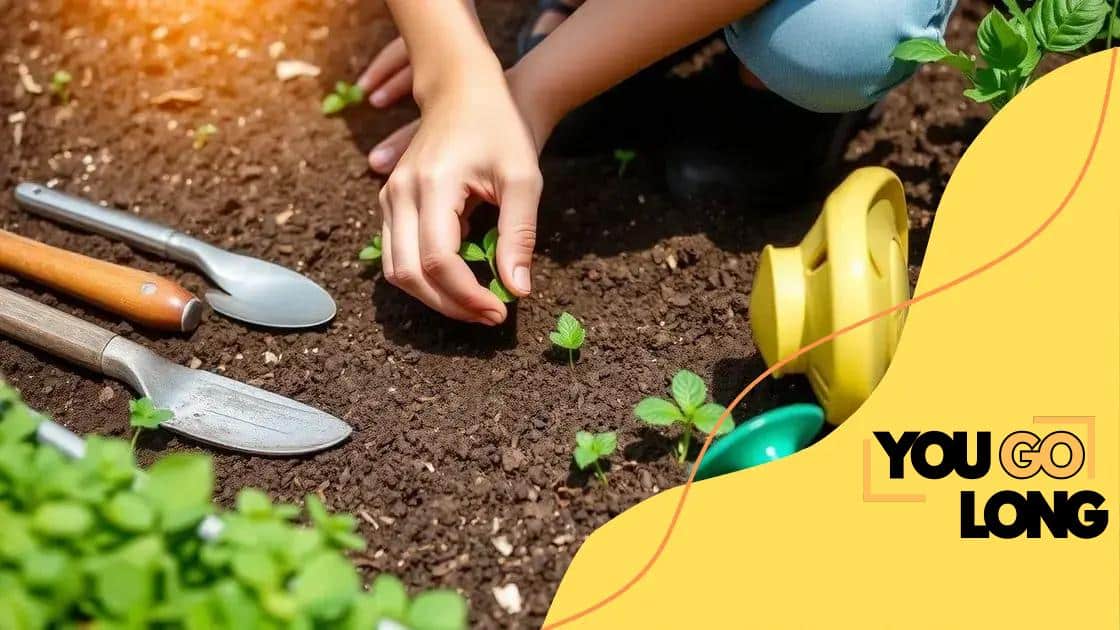DIY garden projects for beginners in 2025

Advertisement
Maintaining your garden successfully involves wise watering, effective pest control, regular weed management, and timely fertilization, ensuring a healthy and thriving garden throughout the seasons.
DIY garden projects for beginners in 2025 open up a world of creativity and growth. Have you ever thought about how easy it can be to start your own garden? Let’s explore simple yet rewarding projects that anyone can enjoy.
Choosing the right plants for your DIY garden
When starting your garden, choosing the right plants is crucial for a thriving space. It’s important to consider factors like your climate, sunlight, and soil type. Understanding these elements will help you select plants that grow well in your environment.
Consider Your Environment
Your local climate plays a significant role in plant selection. For example, if you live in a warmer area, you might want to choose drought-resistant varieties. On the other hand, cooler climates can support plants that thrive in less heat. Take a moment to research which plants do best in your zone.
Advertisement
Types of Plants to Consider
- Flowers: Brighten your garden with a variety of colorful blooms.
- Vegetables: Grow your own fresh produce for healthy meals.
- Herbs: Add flavor to your cooking with aromatic herbs.
Another aspect to think about is sunlight. Some plants need full sun, while others prefer partial shade. You can find this information on seed packets or plant tags. Pay attention to where sunlight hits your garden during the day.
Next, consider your soil. Testing soil pH can provide insights into what nutrients your plants will need. If your soil is too acidic or alkaline, you may need to make adjustments. Adding compost can improve soil health and boost your garden’s productivity.
Local Resources
Don’t forget about local resources! Visit your nearby garden center or nursery to get advice from experts. They can recommend the best plants for your specific area and offer tips on care.
Advertisement
Overall, choosing plants for your DIY garden involves understanding the local environment and the needs of the plants. With the right choices, your garden will flourish and bring joy for years to come.
Essential tools for beginner gardeners
For beginner gardeners, having the right tools is essential for a successful gardening experience. With the right equipment, you can make your gardening tasks easier and more enjoyable. Whether you are planting flowers or vegetables, starting with the basics can set you up for success.
Basic Gardening Tools
Every gardener should have a few basic tools in their toolkit. This includes items like:
- Trowel: A handheld tool useful for digging small holes and transferring plants.
- Pruning Shears: Perfect for trimming plants and keeping your garden neat.
- Hand Rake: Helps to break up soil and remove debris.
Additionally, having gloves can protect your hands from dirt and thorns while you work. Look for durable gloves that fit well and provide good grip.
Supporting Tools
Along with basic tools, there are other items that can enhance your gardening experience. For example, consider having:
- Watering Can: Essential for keeping your plants hydrated.
- Garden Hoe: Useful for breaking up soil and controlling weeds.
- Soil Tester: A handy tool for checking soil quality and pH level.
Understanding how to use each tool effectively can make a big difference. For instance, using a trowel correctly ensures that you don’t damage plant roots when planting. Always read instructions if you are unsure how to use a specific tool.
As you gain more experience, you may want to expand your collection. There are many specialized tools available, but starting with the basics makes it easy to manage your garden efficiently. The right tools can transform gardening from a chore into a delightful hobby.
Step-by-step guide to your first DIY project

Starting your first DIY garden project can be exciting! Follow this simple step-by-step guide to help you through the process. Each step will ensure your project is enjoyable and rewarding.
Step 1: Choose Your Project
Decide on a DIY project that interests you. This could be creating a flower bed, building a raised garden box, or starting a herb garden. Pick something that suits your space and skills.
Step 2: Gather Materials
Once you have your project chosen, make a list of the materials you need.
- Soil: Good quality soil is essential for plant growth.
- Seeds or plants: Choose plants that are suitable for your climate.
- Tools: Gather necessary tools such as a trowel, rake, and gloves.
Having everything ready will make the process smoother and more enjoyable.
Step 3: Plan Your Layout
Before you start digging, take a moment to plan how your garden will look. Think about spacing between plants. Proper spacing helps plants grow without competing for resources. You can sketch a simple layout on paper to visualize it better.
Step 4: Prepare the Area
Clear your chosen area of weeds and debris. Use a rake to smooth out the soil. This preparation gives your plants a good start. If you’re building a raised bed, make sure it’s stable and secured in place.
Step 5: Plant Your Seeds
Follow the instructions on your seed packets for planting depth and spacing. Each type of plant has specific needs, so read carefully. Gently cover seeds with soil and water them lightly.
Step 6: Care for Your Garden
Water your garden regularly, especially during dry periods. Keep an eye on your plants for any signs of pests or disease. Early action can keep your plants healthy and fruitful.
Enjoy the process of watching your garden grow! Each step is important in creating a beautiful and thriving garden space.
Creative garden layouts for small spaces
When dealing with small spaces, finding creative garden layouts is key to maximizing your garden’s potential. You can transform even the tiniest areas into beautiful green oases.
Vertical Gardening
Vertical gardening is a fantastic way to save ground space. Consider growing plants upwards instead of outwards. Using trellises, wall planters, or hanging pots allows you to utilize wall space effectively. This method suits plants like:
- Climbing beans: Easy to grow and prolific in small spaces.
- Tomatoes: Use cages or stakes for support.
- Vining flowers: Create stunning vertical displays with minimal floor space.
Container Gardening
Another option is container gardening. Planters come in various sizes and styles, allowing you to place them on balconies, patios, or even window sills. Choose containers that complement your space and are practical for the plants you want. You might select:
- Pots: Perfect for herbs or small flowers.
- Raised beds: Great for deeper-rooted plants.
- Stacked planters: Utilize vertical space and add interest.
Planting in containers makes it easy to rearrange and change the layout as needed. This flexibility is perfect for experimenting with different designs.
Mixing Plants
Creating a mixed garden with both flowers and edible plants can enhance both beauty and functionality. Consider companion planting, where certain plants help each other thrive. For example, pairing herbs with vegetables can repel pests naturally. You can also:
- Group plants by height: Place taller plants at the back and shorter ones in front.
- Use colors wisely: Combine flowers that bloom at different times for continuous color.
- Incorporate ground covers: These add texture and can help suppress weeds.
With thoughtful planning and layout, small gardens can flourish beautifully. Each creative approach enables you to enjoy gardening, even in limited spaces, making every corner a green delight.
Maintaining your garden: Tips for success
Maintaining your garden is essential for ensuring it thrives. With regular care and attention, you can enjoy a vibrant and healthy garden. Here are some important tips for success that every gardener should consider.
Watering Wisely
Watering is one of the most crucial aspects of garden maintenance. It’s important to know how much water your plants need. Most plants prefer deep, infrequent watering over shallow, frequent watering. This encourages strong root growth. Check the soil moisture by digging down an inch or two. If it feels dry, it’s time to water.
Pest Control
Pests can quickly damage your garden. Look for signs of pest activity and act promptly. You can try the following methods:
- Natural predators: Invite beneficial insects like ladybugs to help control pests.
- Neem oil: A natural pesticide that is safe for plants and pets.
- Companion planting: Some plants repel pests naturally when planted together.
Regularly inspect your plants to catch any infestations early. This proactive approach helps keep your garden healthy.
Weed Management
Weeds compete with your plants for nutrients and water. To manage weeds effectively, keep your garden beds tidy. Regularly pull weeds by hand or use a hoe to remove them from the soil. Staying on top of this task can prevent weeds from taking over.
Fertilizing Your Plants
Plants need nutrients to thrive. Fertilizing adds essential nutrients back into the soil. Use organic compost to enrich the soil naturally. This not only helps the plants but also improves soil health. Apply fertilizer during the growing season, following package instructions for quantity.
Seasonal Care
Adapting your care routine as the seasons change is vital. In the spring, focus on planting and fertilizing. Summer care includes regular watering and pest checks. Fall is the time for harvesting and preparing your garden for winter. Trim dead plants and consider adding mulch to protect your soil during colder months.
With these tips in mind, you’ll find your garden flourishing throughout the seasons. Consistent care is the key to a healthy and productive garden.
In conclusion, maintaining your garden requires consistent effort but brings great rewards. By following these tips, you can ensure that your plants stay healthy and vibrant. Remember to water wisely, manage pests and weeds, and provide the right nutrients. Seasonal care will also help you make the most of your gardening experience. With these practices, you will enjoy a flourishing garden that brings joy and beauty to your space.
FAQ – Frequently Asked Questions about Garden Maintenance
How often should I water my garden?
Water your garden deeply and less frequently to encourage strong root growth. It’s usually best to water in the early morning or late afternoon.
What are natural ways to control pests?
You can invite beneficial insects like ladybugs, use neem oil, or practice companion planting to keep pests away.
How can I effectively manage weeds?
Regularly check your garden and remove weeds by hand or with a hoe to prevent them from taking over.
When should I fertilize my plants?
Fertilize your plants during the growing season using organic compost to replenish nutrients in the soil.





